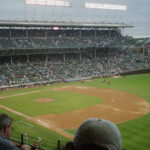Range Factor (or RF for short) is a baseball statistic designed to help to quantify a baseball player’s fielding ability. Taken together with Fielding Percentage (FP%), it can be quite helpful in evaluating a player’s defensive abilities.
Fielding Percentage is simply a ratio that shows the percentage of plays a particular fielder makes out of all plays he attempted to make. The formula is:
Fielding Percentage = (Assists + Putouts) / (Assists + Putouts + Errors)
While a useful statistic, Fielding Percentage does have a few flaws that would make using it alone to evaluate a fielder a mistake. One of the biggest issues is that it only counts those plays that a fielder attempts to make. If Player A has limited fielding range, but makes most of the plays he gets to, he’ll have a high Fielding Percentage. What about the balls he didn’t get to, though, that a player with more range might have gotten to? Those all went for hits. Now, what if Player B makes all the plays that Player A made, plus attempted 1/3 more total plays, only making half of them. Well, he’ll have turned about 15% more possible hits into outs, a very good thing, but his fielding percentage would actually be lower than that of Player A.
Range Factor measures the number of plays a fielder attempts in an average game. The formula is:
Range Factor = (Assists + Putouts) / Games
Range Factor is displayed as a number with two numbers after the decimal point. For example, say a player has 344 Assists and 211 Putouts in 150 games. The RF is calculated by adding 344 and 211 (a total of 555) and dividing by 150 and is written as 3.70.
Range Factor is most helpful when compared to the league average RF at that player’s position, and when you take Fielding Percentage into the equation. For example, in 2005, Derek Jeter of the New York Yankees registered 454 Assists, 262 Putouts, and 15 Errors in 157 Games. That gives him a Fielding Percentage of .979 and a Range Factor of 4.56. How do those compare to the rest of the league? The average major league shortstop turned in a RF of 4.17, and “the fielding percentage a league average player would have in that many opportunities” was .972. Jeter won his second straight Gold Glove Award (voted on by coaches and managers) in 2005. Was he a deserving winner? Maybe, maybe not, but he was at least an above average fielder in 2005.
One note on Range Factor: ideally, it would be calculated using the total innings that a player played at his position each year. This would be more accurate than simply using total games played, because it does not account for games in which a fielder is removed from the game before it’s completion, or for extra inning games. Unfortunately, total innings played per position are not often kept, and accurate counts are only available for seasons from about 2000 on. Because of this, the RF formula above is often called RFg (or Range Factor per Game). To calculate Range Factor using innings, which is called RF9 (or Range Factor per 9 Innings), the formula is:
RF9 = 9 x (Assists + Putouts) / Inning
Reference:
- Fielding Statistics, including Range Factor and Fielding Percentage, are available at www.baseball-reference.com




